John Oxley and the Brisbane River (Maiwar)
By Anna Thurgood, Engagement Officer | 29 November 2023
John Joseph William Molesworth Oxley was born at Kirkham Abbey in Yorkshire, England, in mid-1784 and joined the Royal Navy at the age of 15. He had travelled to Australia a number of times before securing the position of Surveyor General, on his second attempt, in 1812.
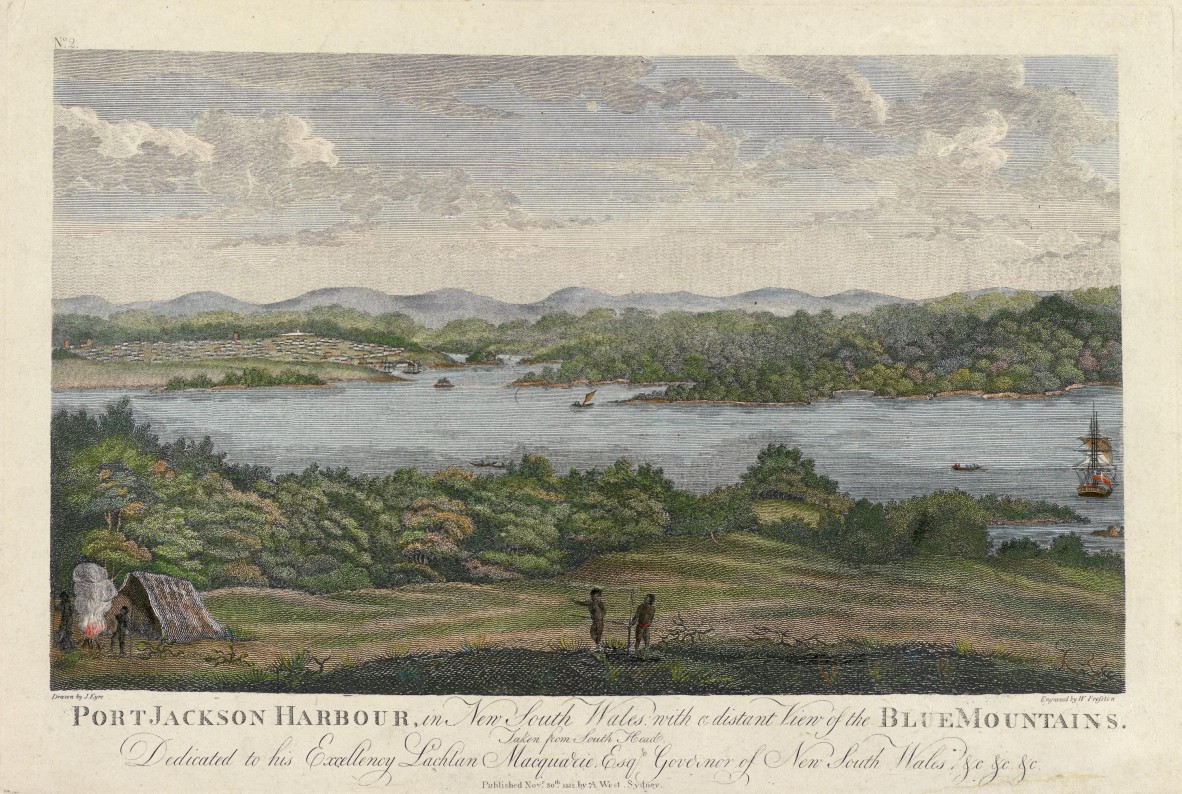
Port Jackson Harbour, in New South Wales, with a distant view of the Blue Mountains, 1812. Walter Preston (engraver); John Eyre (after). Hand-coloured engraving on lined paper. The Joseph Brown Collection, National Gallery of Victoria. Presented through the NGV Foundation by Dr Joseph Brown AO OBE, Honorary Life Benefactor, 2004. Courtesy National Gallery of Victoria, Melbourne.
When Oxley arrived later that year, Sydney Town had grown considerably. The British government had appointed Governor Lachlan Macquarie in 1810 to bring law and order back to the colony after the ‘rum rebellion’ that saw Governor William Bligh ousted in what was effectively a military coup. Macquarie was enthusiastic about actively expanding the colony. He set about constructing grand public buildings. He granted convicts who had served their sentences (‘the emancipists’) and free settlers large parcels of land around Sydney, and elevated ex-convicts to positions of authority in the fledgling society. He also vigorously supported exploration further afield.
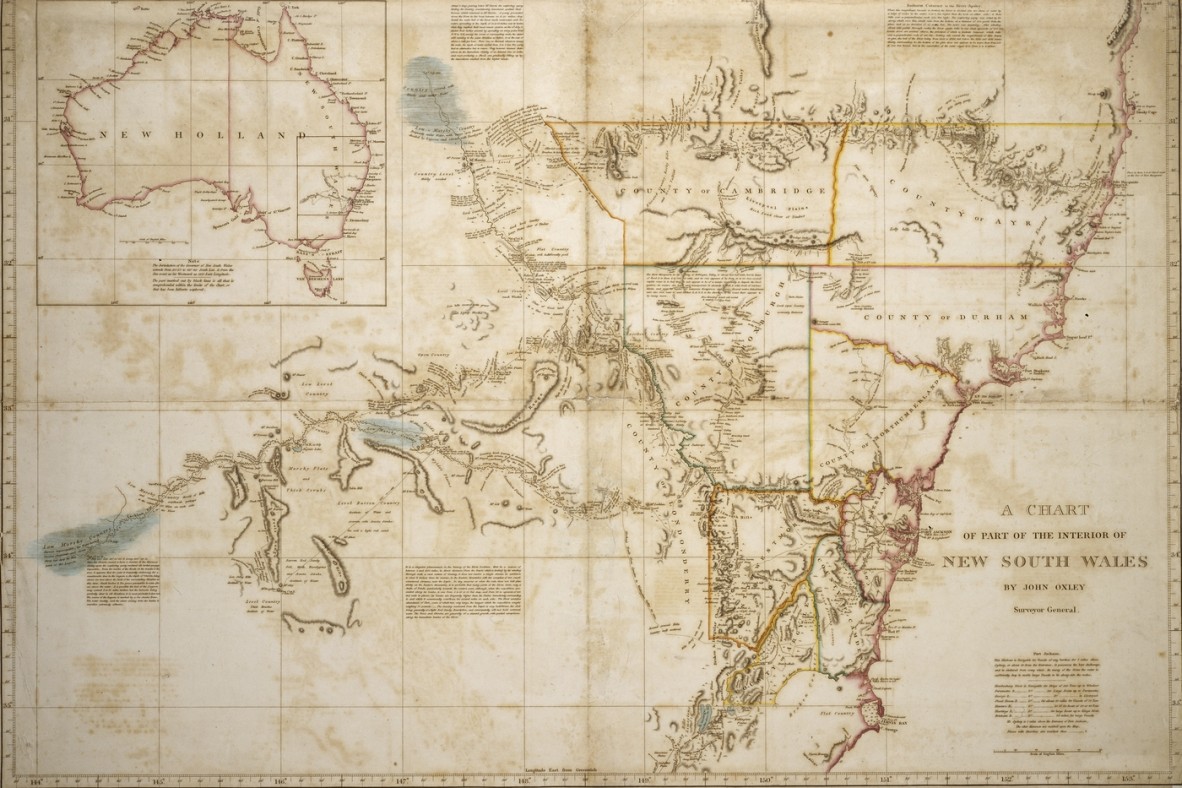
A chart of part of the interior of New South Wales, 1825. John Oxley (cartographer); Aaron Arrowsmith (publisher). Call no. Z/Cc 82/1-3 , Cc 82/1-3. Dixson Map Collection, State Library of New South Wales.
Oxley undertook several expeditions for Governor Macquarie, arousing great interest in the interior of Australia and inspiring future explorers Sturt and Mitchell. He also surveyed and recommended the site of Port Macquarie for settlement. Meanwhile the politics of Britain were beginning to be felt in the colony of New South Wales. And while Governor Macquarie had tendered his resignation in 1817, it wasn’t accepted until the Colonial Secretary, Lord Bathurst, received the Bigge Report in 1821.
The report, compiled by Thomas Bigge a former Chief Justice of Trinidad at the behest of Lord Bathurst, had major implications for the colony of New South Wales and effectively ‘reset’ the nature of convict Australia. At a time of high unemployment at home, Bathurst was under pressure to reduce the cost of the colony to the Empire. The economic desperation of the lower classes saw crime rates rise, placing extra pressure on the convict transport system. Bathurst was particularly concerned that transportation to the colony was no longer viewed with dread, but rather was seen as better than being destitute in Britain. In a letter to Bigge, he stressed that:
transportation to New South Wales is intended as a severe punishment, applied to various crimes; and as such must be rendered an object of real terror to all classes of the community.
The Bigge Report, published as a parliamentary paper in 1822, laid out a blueprint for promoting the private sector and fostering an export economy based on wool. Wealthy immigrants would be lured to the colony with large land grants and the provision of free convict labour. It also importantly called for the establishment of places of ‘secondary punishment’ where recidivist convicts would be subject to the harshest possible treatment.
It was around this time that John Oxley met and married Emma Norton in Sydney in 1821. Oxley already had three illegitimate daughters to two different women and an earlier engagement to Elizabeth Macarthur (daughter of John Macarthur who had led the ‘rum rebellion’ against Governor Bligh) was broken off by her father when he discovered the true extent of Oxley’s debts. Governor Macquarie had granted Oxley 600 acres near Camden, increased to 1,000 acres in 1815, and Oxley named this property Kirkham after his birthplace. While he maintained a substantial ‘town home’ in Sydney, he had built a large homestead at Kirkham and it was here that Emma lived and raised their two sons – John, born in 1824 and Henry, born in 1826 – whilst managing the property which raised and bred sheep.
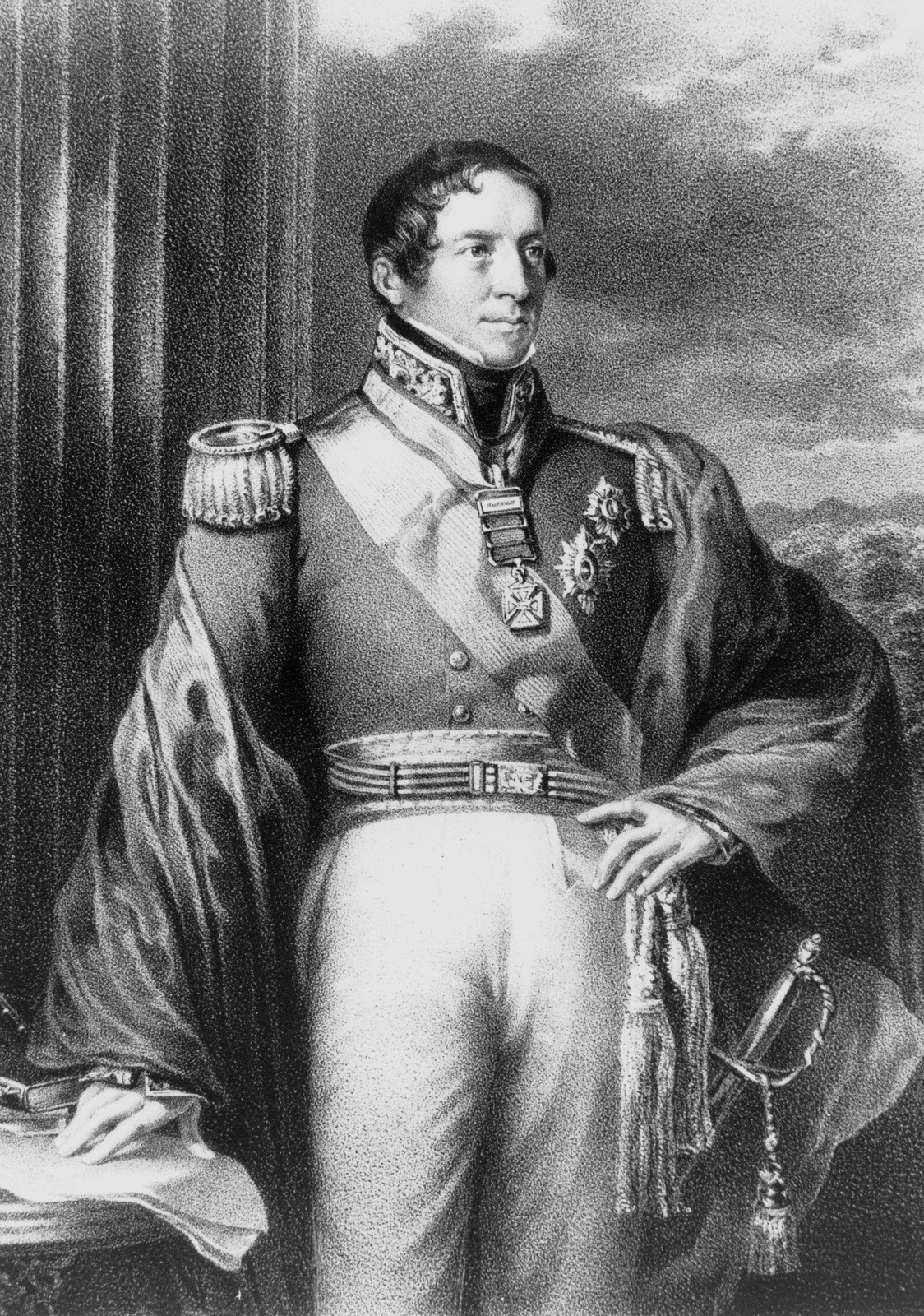
Sir Thomas Makdougall Brisbane, n.d. Creator unknown. Negative no. 69011. John Oxley Library, State Library of Queensland.
In the new political milieu Sir Thomas Brisbane was installed as the next Governor of New South Wales in 1821 and made new penal settlements a high priority. Port Macquarie had been established earlier that year, based on Oxley’s surveys and recommendations. Now, Brisbane tasked Oxley with finding another suitable site in ‘the north’. Oxley was sent to survey and provide recommendations on Port Bowen, Port Curtis (Gladstone) and Moreton Bay in 1823.
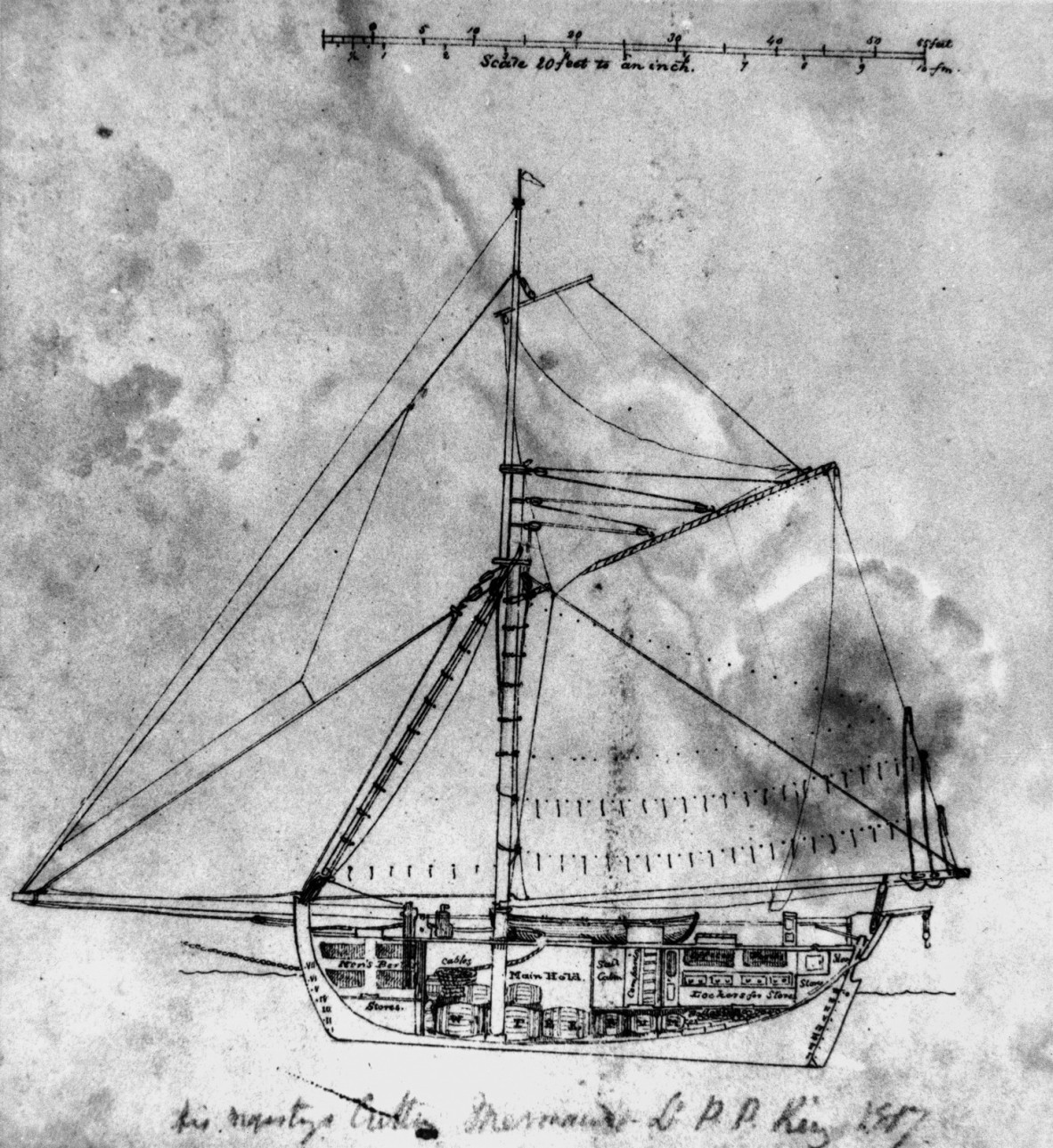
Mermaid (ship), ca.1817. Creator unknown. Negative no. 109521. John Oxley Library, State Library of Queensland.
NOTE: inscription at the bottom reads "His Majesty's Cutter Mermaid, Lt P.P. King, 1817". Philip Parker King used the Mermaid as a survey ship between 1817 and 1820, after which it was condemned and sold to the colonial government in 1823. Botanist Alan Cunningham accompanied King on his surveys, and would later accompany John Oxley up the Brisbane River, on his second journey in 1824.
Oxley set sail on the government brig, Mermaid and visited Port Curtis first. After 16 days he deemed the site unfit due to a lack of fresh water. He then decided to turn south and head for Moreton Bay, ignoring Port Bowen altogether. Oxley entered the bay on 29 November and anchored at Point Skirmish, on the southern tip of Bribie Island. Almost immediately he came across two ‘ticket of leave’ convicts, Thomas Pamphlett and John Finnegan, who had been living with local Aboriginal people after being shipwrecked during a timber-getting mission south of Sydney. Oxley already suspected there was a large river entering the bay, but the two men confirmed it.
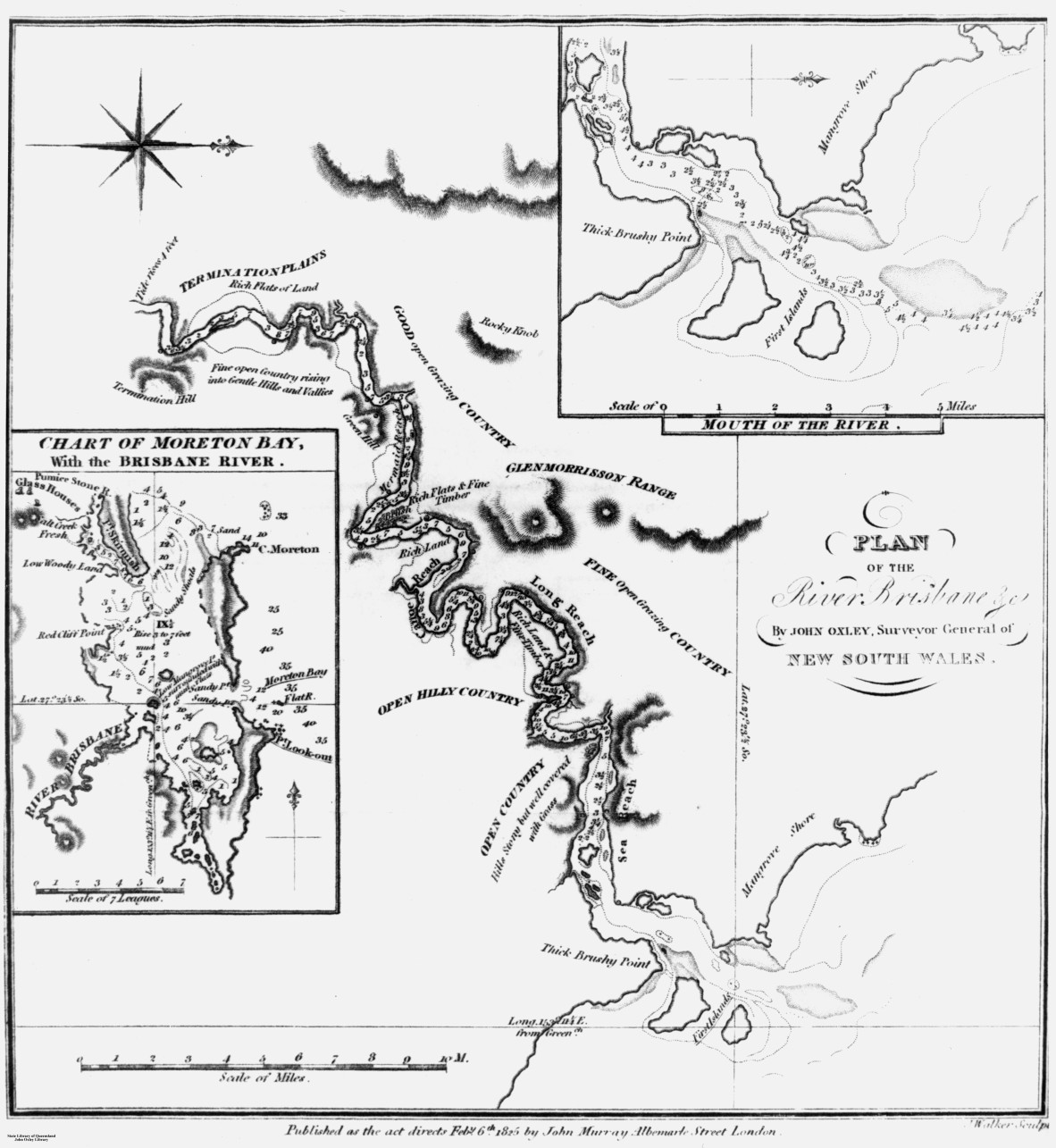
Plan of the River Brisbane and chart of Moreton Bay, as drawn by John Oxley, 1823. Negative no. 69012. John Oxley Library, State Library of Queensland.
On 1 December 1823, Oxley set out in a whaleboat with a small crew and a ‘reluctant’ Finnegan acting as a guide. Finnegan accidentally led the party to the wrong river first, which Oxley named Deception River. It was later renamed Pine River due to the numerous hoop pines growing in the area. After camping overnight at nearby Shorncliffe, they finally found the entrance to Maiwar, the Brisbane River (later named by Oxley in honour of Governor Brisbane) helped by an ingoing tide, hidden behind an island and entered it at around 8am on 2 December 1823.
Panoramic View from River Terrace [Kangaroo Point] showing the Brisbane River and the Botanic Gardens at Gardens Point, ca.1870. Photograph by Daniel Marquis. Negative no. 38725. John Oxley Library, State Library of Queensland.
John Oxley seems to have been a somewhat mercurial character. In 1824 he was appointed to the Legislative Council of New South Wales but was not reappointed the following year. As Surveyor General, he drafted regulations for the sale of land and in 1825, was appointed as one of three commissioners to carry out a full survey of the colony and its division into counties, shires and parishes. Oxley was heavily involved in the public and cultural life of the colony and had extensive commercial interests as well as being paid handsomely by the government for his work. However, he proved to be a poor financial manager. When he died on 26 May 1828 at Kirkham aged only 42 years old, after a long illness said to be caused by the ‘privations which he suffered during the Several Expeditions on which he was employed in exploring the Interior’, his widow was left so impoverished the government was asked to assist. While she was never granted a pension, Oxley’s two sons were granted 5,000 acres of land in recognition of their father’s service.
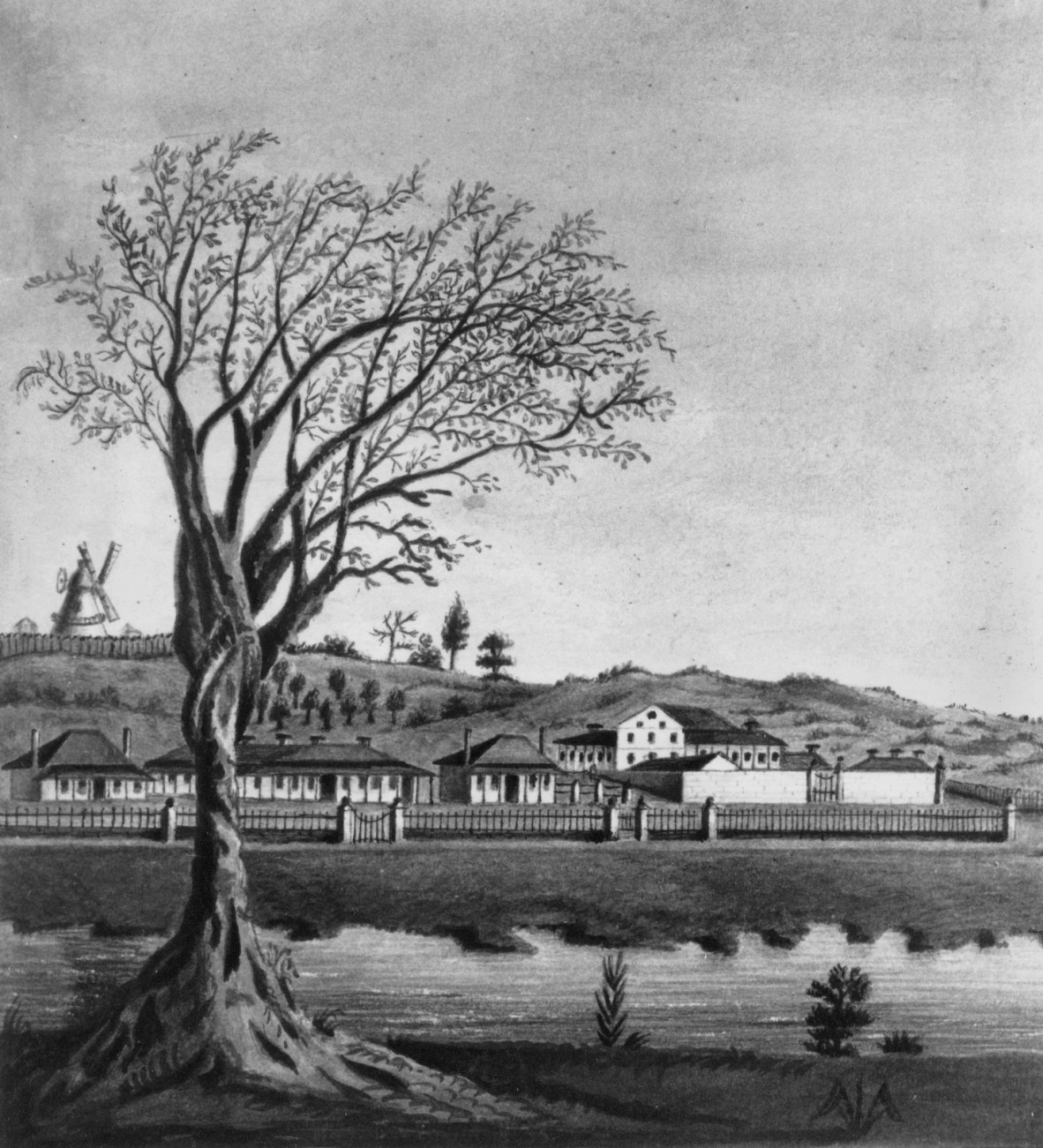
Early drawing of a section of the town of Brisbane, Queensland, including the Convict Hospital, 1835. Creator unknown. Negative no. 138146. John Oxley Library, State Library of Queensland.
As mentioned, this article is the first in a series following John Oxley's journey up Maiwar, the Brisbane River, 200 years to the day later. Articles will be published from 2 to 5 December, with a daily account of what John Oxley and his crew saw and encountered as they journeyed 50 miles upriver, gleaned from his own field notes, his report to the Governor and other sources. We hope you enjoy the journey.
Further resources
Accession 33036 John Oxley Papers
Report of an expedition to survey Port Curtis, Moreton Bay and Port Bowen: with a view to form convict penal settlements there, 1825. John Oxley. Call no. RBJ 994.3 OXL. John Oxley Library, State Library of Queensland.
Plan of the river Brisbane by John Oxley, Surveyor General of New South Wales, created 6 February 1825. John Oxley (surveyor); John Walker (sculpt.). Call no. RBM 841.15 1825 00265 E. John Oxley Library, State Library of Queensland.
The Explorers of the Moreton Bay District 1770-1830, 1972. J.G. Steele. Published by University of Queensland Press. Call no. Q 919.432042 STE C2. John Oxley Library, State Library of Queensland.
Field Book: Exploration of Brisbane River, 30 November 1823 - 5 December 1823. John Oxley (surveyor). Item ID: ITM291077. Queensland State Archives.
Comments
Your email address will not be published.
We welcome relevant, respectful comments.